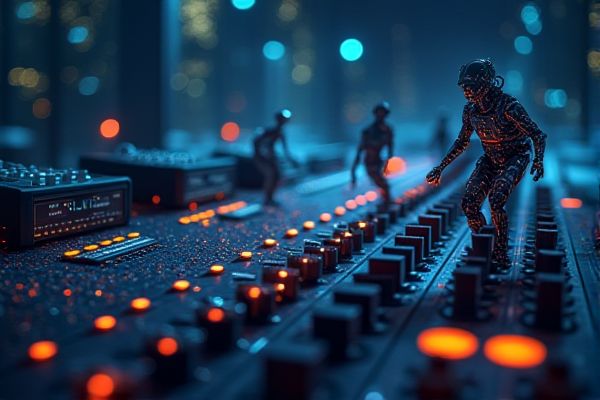
AI contributes significantly to music composition and production by offering tools for generating melodies, harmonies, and arrangements, enabling artists to explore new creative avenues. Algorithms analyze vast music databases, identifying patterns and styles that inspire musicians to experiment beyond traditional boundaries. In production, AI assists in sound design, mixing, and mastering, streamlining workflows and enhancing the sonic quality of recordings. Collaborative AI platforms allow artists to co-create with technology, merging human creativity with computational power for innovative musical outcomes.
AI usage in music composition and production
Automated Music Generation
AI can enhance music composition and production by automating various tasks. Tools like OpenAI's MuseNet and AIVA enable musicians to generate unique melodies and harmonies, potentially saving time on composition. This technology allows for exploration of diverse musical styles, providing new creative possibilities. The chance for collaboration with AI can also facilitate the development of innovative soundscapes in genres such as electronic music.
Emotion Recognition in Music
AI can enhance music composition and production by analyzing emotional responses to different musical elements. For instance, Emotion Recognition in Music technology allows composers to create pieces tailored to evoke specific feelings in listeners. This capability opens avenues for music professionals to design more personalized and engaging experiences. The integration of AI in creative processes offers the possibility of generating unique compositions that resonate deeply with audiences.
Intelligent Mixing and Mastering
AI in music composition and production provides opportunities for more efficient workflows and innovative sounds. Intelligent mixing and mastering tools, such as LANDR, can enhance audio quality by automating processes typically done by professionals. Musicians and producers might benefit from these advancements, allowing them to focus on creativity rather than technical details. This shift could lead to a new wave of diverse music styles and collaborations across genres.
Personalized Playlists
AI tools are increasingly being utilized in music composition and production, allowing for innovative sound creation and arrangement. These technologies can analyze listener preferences, leading to the development of personalized playlists that cater to individual tastes. For instance, platforms like Spotify employ algorithms to recommend songs based on user behavior, enhancing the listening experience. The chance for musicians to collaborate with AI offers the possibility of transforming traditional music-making processes and reaching wider audiences.
AI-driven Sound Design
AI usage in music composition and production presents opportunities for enhancing creativity and efficiency. Tools like OpenAI's MuseNet can generate melodies and harmonies, allowing artists to explore new musical territories. In AI-driven sound design, algorithms can analyze audio samples to create innovative sounds, giving producers a competitive edge. These advancements could lead to unique collaborations and faster production times in the music industry.
Real-time Music Analysis
AI can enhance music composition and production through tools that analyze patterns and suggest creative options. Real-time music analysis enables musicians to adapt their performances dynamically, responding to audience reactions or changing musical contexts. For example, software like AIVA offers composers opportunities to explore new styles and arrangements instantly. This technology opens possibilities for innovative soundscapes and personalized music experiences.
Adaptive Music for Games
AI technology offers the possibility of enhancing music composition and production by streamlining creative processes. For example, game developers can use adaptive music to tailor soundtracks that respond dynamically to gameplay, creating a more immersive experience. The ability of AI to analyze patterns in music can result in unique compositions that reflect player choices and moods. This potential advantage opens up new avenues for innovation in both music and gaming industries.
Virtual Music Collaborators
AI in music composition and production can enhance creativity by generating new melodies and harmonies based on existing styles. Virtual music collaborators, like OpenAI's MuseNet, offer musicians the opportunity to experiment with various genres and sounds seamlessly. This technology can streamline the production process, allowing artists to focus more on their creative vision. The potential for AI to assist in fine-tuning songs may lead to innovative tracks that capture diverse audiences.
Genre Detection Algorithms
AI can enhance music composition and production by providing tools that automate repetitive tasks and suggest creative elements. Genre detection algorithms, for example, can analyze music tracks and classify them accurately, allowing producers to target specific audiences more effectively. By leveraging these technologies, artists may find new ways to create and refine their work, thus possibly gaining a competitive edge in the industry. Institutions such as Berklee College of Music are exploring these innovations, highlighting the potential benefits in education and professional practice.
Predictive Music Trend Analysis
AI has the potential to enhance music composition and production by analyzing large datasets to identify emerging trends. For example, tools like Amper Music can generate original tracks based on user-defined parameters, allowing musicians to experiment with new sounds. Predictive music trend analysis can help record labels and artists anticipate shifts in listener preferences, potentially increasing their market reach. This analytical approach may offer a competitive edge in an evolving industry landscape.
 techknowy.com
techknowy.com